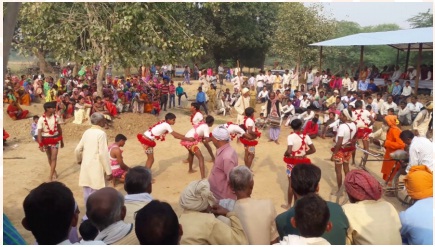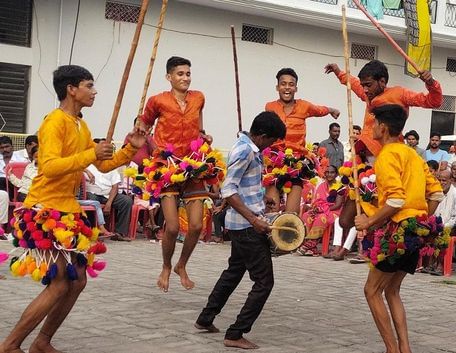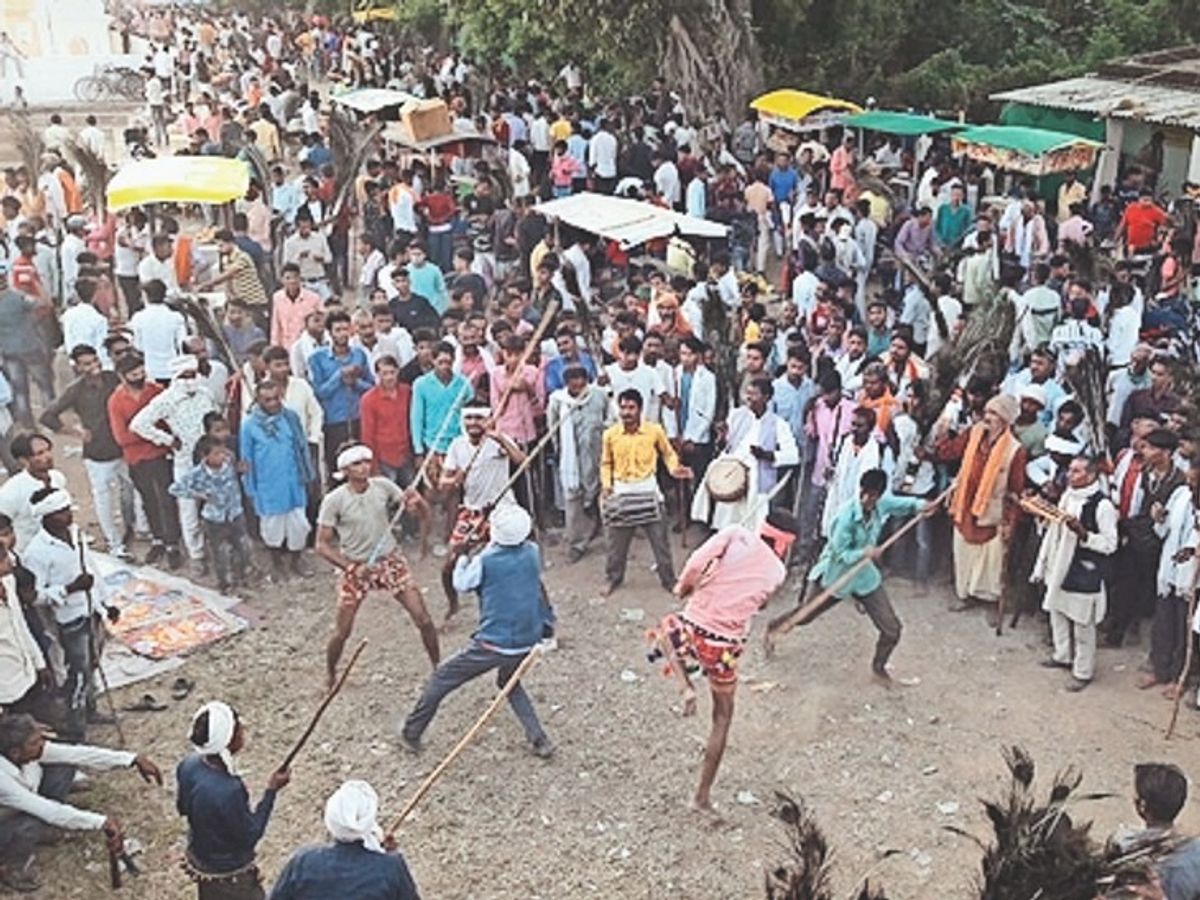Introduction:
The heartlands of Uttar Pradesh are densely populated with rural populations. Ancient celebrations are home to a myriad of folk art forms, each bound to the communities. Diwari dance is the local tradition of Bundelkhand to celebrate the festival of Diwali. It comprises districts of Banda, Chitrakoot, Mahoba, Jhansi and Lalitpur of Uttar Pradesh and Sagar, Chattarpur, Tikamgarh, Datiya and Panna of Madhya Pradesh. The performance starts each year after main Diwali on the day of Govardhan Puja (Annakut) and ends till the Dev Uthani ekadashi, known as Gyaras locally. The Diwari dance is also called as Moniya dance, Pai danda, and Strip Fight diwari.

Origin of Diwari Dance: Historical and Cultural Background

There are many sayings and beliefs behind the origin of the Diwari dance. It is performed on the day of Goverdhan Puja. Villagers craft earthen or Cow dung mounds representing Mount Govardhan. It reminds the legendary story of Krishna lifting the Govardhan hill to protect villagers from the heavy rains due to the curse of Indra Dev. Another dimension is to express gratitude towards God for the good harvest at the end of the monsoon and to pray for prosperity for the year ahead.

Many oral stories suggest the ritual of the Diwari dance is centuries old. Local versions evolved among different communities and regions. Diwari dance is performed by the Yadavs and Ahir community; they consider themselves as the cow of Lord Krishna. They drink water like a cow keeping grass in its mouth. They carry a large bundle of peacock features. They pledge a fast of silence (Maun Vrat) for the whole day till they visit all the temples of the five villages (Maun Charana). They must continue it for twelve years. Performers are mainly male farmers, cattle herders, and labourers. Although recently. The villagers gather in fields and temples to be part of the performance. A large audience also comes to encourage the dancers. Mauniyas moved from house to house for the blessings.
The Diwari/Muniya Dance: Attire, Forms and Performance
Diwari dancers wear colourful turbans, kurtas, dhotis, and anklets (ghungroos). They carry wooden sticks, known as “sotis” or gathis. Their attires are decorated with peacock feathers, mirrors, cowrie and bells. Their face is coloured with mud, showing their connection and respect to agrarian roots.
There are many styles of the Diwari dance, like Pai Danda, Khapari (skull) far (torn), Dadhi (chin) tor, Ghuma hul hul, ek takana (leg), do takana, shaiahi (stick) Diwari, etc. Each has its own characteristics and significances.
The dance itself is visually dazzling. Diwari dance consists of singers, musicians and dancers. They tap their sticks together, sway, spin, and sometimes leap high into the air. Their feet and sticks copy the way cows move in a herd, the sound of running water, or the beat of festival drums. Musicians play drums like dholak and nagada, as well as manjira, ramtula, jhanjh, and harmonium. Singers use hand motions and facial expressions, singing folk songs about Krishna, Govardhan, and other local gods.

Diwari dance songs are playful, celebratory, and sometimes satirical. Lyrics might recount the Govardhan myth, comment on harvests, or offer social commentary through humour and puns. In Bundelkhand, the songs are often call-and-response, with a lead singer (“bhag”) and chorus repeating lines emphasising community participation. Diwari songs are sung in the Tarasapatak and Vilambit rhythm. The use of ‘Aare’ and ‘O’ at the beginning and in the middle of the lines, and ‘re’ at the end. For example, lyrics of a folk Diwari dance given below:
Sada Bhawani dahini aur, sanmukh rahaita Ganesha re
Paanch deva raksha karai, so Brahma Vishnu Mahesha re
Chitrakoot me Ram rahe, lala Rahiman Awadh naresha re
Aur jaa par bipda parat hai, aawat bhaiya so aawat yahi ya desha re
Thumak thumak dholwa baje, lala o
Jehra lahariya aa haan le aa re
Saas nanadiya ya baar ekai bairan
So dholwa na dekho na haan de aa re
The meaning of lyrics:
May Goddess Bhawani stay to the left, may Lord Ganesha face us—good fortune is with us.
Let Brahma, Vishnu, Mahesh and the five gods protect us as we sing and dance today.
In Chitrakoot, Lord Rama lives—the true king of Awadh, always remembered.
If you have troubles, come to this land; here, there is hope and help.
The drums sound as we dance, and laughter fills the air!
See the flags waving, come join the joy and celebration!
In families, small squabbles happen, but let music unite us.
Don’t mind the little fights—sing and clap along, let happiness lead!
Artistic Motifs and Symbolism

Earthen mounds of Govardhan are crafted at temples and in homes. It is decorated with flowers and circles of turmeric or vermillion. Dancers circle these mounds symbolically lifting Govardhan as Krishna. The peacock feathers and mirrors in the costumes point out Krishna’s iconography. Peacock feathers symbolise beauty and charisma. Mirrors symbolise self-reflection and the sun’s bounty. The dance’s stick routines echo martial traditions. The Diwari dance emphasises celebration and unity. The tap-tap, whirl and leap of the sticks create an auditory and visual rhythm that unites the dancers with nature and music. Stick dance is also a symbol of protection, as Lord Krishna teaches his friends to protect themselves through stick fighting.

Challenges

In recent decades, Diwari has faced challenges. Urbanisation, inter-state migration, and changing work patterns have led to a decline in the enthusiasm of rural populations. Factory work and city jobs often keep younger members away from village festivals. As a result, knowledge of dances, traditional songs, and costume-making has faded. Additionally, modern entertainment, television, mobile phones and other electronic media replace traditional gatherings during Diwali. A smaller number of people take an interest in the folk dance. People are now used to watching reels and having short attention spans to watch traditional performances. In the village, dancers are not professional; they learnt it just by watching elders and did not practice with other teammates to coordinate it.
Some groups struggle with financial support to buy costumes or arrange all music instruments, as local leaders may not prioritise funding for folk art, so participants are not always in proper attire, which is the core of the dance. Song sung by elderly people with a simmering voice, they can not afford a sound system. They do practice full year and sing it once a year. Villagers are not much concerned with extending their reach to the national and international level. Due to these flaws, it remains limited to a few districts only to provide it recognition.

Recent Revival Efforts
Local and state organisations have taken a few steps to revive the Diwari/Muniya dance. In Banda, Hamirpur, and Jhansi districts, organised Diwari dance competitions in the cultural fairs. The Department of Culture in UP has begun sponsoring Diwari and Muniya dance troupes for performances at government events and festivals. Journalists from Khabar Lahariya, Dainik Jagran have started covering Diwari live. Some communities in Bundelkhand have revived old lyrics and props, encouraging women and children to join. In Banda villages like Kamasin, Mahua, and Atarra, elders lead preparations, teaching steps and songs to children days before the festival. The local panchayat helps sponsor public spaces for practice. Dancers receive gifts, laddoo, local sweets, and gamcha cloth from each household they perform at. Ramesh Pal from Banda district formed the Ramesh Pal Nataraj Jan Kalayan Samiti in 1990. He and his group travel to perform across India.

The Way Forward: Preserving Diwari
To ensure the survival of the Diwari/Muniya, Dancers should practice it as a profession. As each village has their separate dance team, they dance barefoot in the dust of the street in front of a small audience. If a group of villages collaborate and organise it at a place on a large level, it would attract the interest of a larger audience, and provide a dance stage to get sponsors for costumes and props. Organising a competition is a great initiative to promote it and give a prize to the winning team, and appreciate them for working hard to sharpen their dancing skills. A few groups implement to practice it professionally, but it needs more effort to expand the dance form. Merging with modern dance form while maintaining its uniqueness, and recording dance properly available on social media can preserve the Diwari dance for upcoming generations.

Universities and schools should include folk dances in their cultural events. Student projects and competitions can draw the interest of young participants. Government funding for sticks, costumes, and instruments makes it easier for dancers to sustain themselves. Local NGOs can connect artisans to make costumes and props with income opportunities. YouTube and social platforms could also help rural troupes reach wider audiences. Some successful troupes have already started uploading their dances and teaching through online content. Elders and young participants should collaborate in documenting not just steps but the meaning, stories, and rituals around Diwari. This keeps the dance rooted in community, not just performance.
Conclusion
Diwari dance not only entertains but keeps the lore alive for new generations. It is performed in the older forms when resources were limited; now, villagers have access to more props, sound systems, and lighting stages to use and make it more interesting to popularise. Folk dance required the attention and recognition beyond the regional boundaries to survive, evolve and grow. Diwari dance is not just a dance; it’s an identity of the region’s vibrant celebration of the Diwali festival. Proper effort can make it popular like other classical dance forms.

References
1. https://www.boloji.com/articles/53436/diwari-pai-danda-a-folk-dance-of-bundelkhand
4. https://www.thehindu.com/entertainment/art/aspiring-for-a-dand-y-place/article25080350.ece
10. https://www.patrika.com/sagar-news/diwari-nratya-1-1919919





बहुत सुंदर लेख।। परम्पराओं को जीवंत करने वाला लेख
👏👏